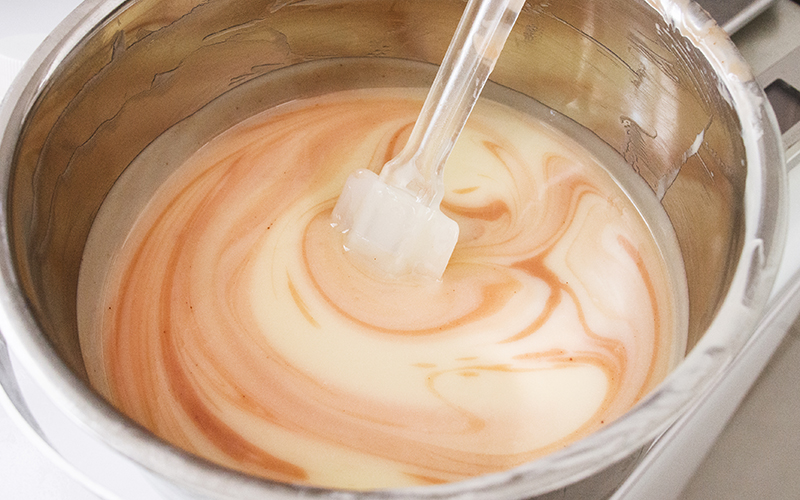Blended ingredients are ingredients that you add to your cosmetic that contain specific individual components. Common blended ingredients are color additives (e.g. “colored mica”), preservatives, infusions or extracts, and some commercial products (example: BTMS-25 or some emulsifiers).
The regulations mandate that when listing ingredient declarations for cosmetics, all the ingredients must be listed, and that includes the components of a blended ingredient. In order to list them correctly, you must determine the percentage of each component in the whole.
It can take a little bit of math to figure out.
Where to Get the Amounts?
First, you need the percentages of the components in the blended ingredient.
When you purchase a blended ingredient you should be able to get that information from the supplier. It will be on the website in the product description, in the Safety Data Sheet, or in the Certificate of Analysis. If you can’t find it there, then ask for it.
Fragrance components don’t have to be disclosed, so it is unlikely that you will be given those. See Ingredient Declaration: Fragrance and Flavor for how to handle that.
You also are unlikely to get the components of color additives, but that’s okay since you can just list the color additive components at the tail end of the ingredient declaration anyway (see below).
Alternate Order of Ingredients
When you have blended ingredients, listing the alternate order of ingredients in your ingredient declaration can be helpful. It is:
- Ingredients present at more than 1% in descending order of predominance.
- Ingredients present at 1% or less in any order.
- Color additives, regardless of amount, in any order.
The benefit here is that you don’t really need to figure out the exact amount of a component if it is present at 1% or less, or if it is a color additive.
Calculating the Percentage of Components
The formula to figure out the percentage of a component in the whole is:
[ % ingredient in the whole]
x [ % component in the ingredient ]
————————————
= [ % component in the whole ]
Keep in mind that to multiply percentages, it’s easiest if you convert to decimal:
i.e. 40% = .40
Let’s say you used 4% BTMS-25 in your formulation. BTMS-25 is made up of 75% cetearyl alcohol and 25% behentrimonium methosulfate. Then your calculation for the cetearyl alcohol would be
.40 [4% – the percentage of BTMS-25 in the whole]
x .75 [ 75% – the percentage of cetearyl alcohol in the BTMS-25 ]
————————————
= .30 [ 3% – the percentage of cetearyl alcohol in the whole ]
OR .40 x .75 = .30 … the same as .. 40% x 75% = 30%
You can use the same formula for figuring out any type of blended ingredient.
There are some special cases:
Infusions and Extracts
For infusions and extracts, the bulk of the material is removed. You soak your calendula petals in olive oil for “calendula-infused olive oil,” But you can’t possibly figure out the amount of calendula “goodness” that remains in the oil after you remove the petals. In that case, it is likely to be less than 1%, so you can place the extract portion in any order among the other ingredients present at 1% or less. The carrier (in this case the olive oil) is placed in the ingredient declaration based on its total percentage in the whole.
Note that the “extracted part” is always called “extract” regardless of whether it is an infusion, tea, extract, or tincture.
Preservatives
Usually, you can get the exact amount of the components of a commercial preservative. However, since they are typically used at 1% or less in your formulation, all of the components would be present at 1% or less as well. That makes it easy to place them in the ingredient declaration.
Why does it matter?
First off, a correct ingredient declaration is required by law and regulation. Technically, a product with an incorrect ingredient declaration is misbranded and therefore prohibited from being sold.
Secondly, consumers rely on the ingredient declaration to see what is in the product. They use it to determine if there are ingredients that they want, or don’t want–so accuracy is important to the consumer. When they feel confident that the ingredient declaration is correct, it builds trust.
Finally, presenting an incorrect ingredient declaration can also be considered “false and misleading.” At a state level, false and misleading statements on product packaging can lead not only to enforcement by officials, but to lawuits by consumers with over-active attorneys.
Bottom line: Make sure your ingredient declaration is correct, and that all the components of your blended ingredients are properly included in the ingredient declaration.


Leave a Reply